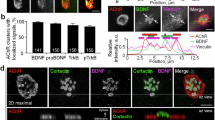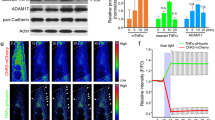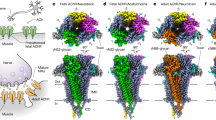Abstract
The development of chemical synapses is regulated by interactions between pre- and postsynaptic cells. At the vertebrate skeletal neuromuscular junction, the organization of an acetylcholine receptor (AChR)-rich postsynaptic apparatus has been well studied. Much evidence suggests that the nerve-derived protein agrin activates muscle-specific kinase (MuSK) to cluster AChRs through the synapse-specific cytoplasmic protein rapsyn. But how postsynaptic differentiation is initiated, or why most synapses are restricted to an ‘end-plate band’ in the middle of the muscle remains unknown. Here we have used genetic methods to address these issues. We report that the initial steps in postsynaptic differentiation and formation of an end-plate band require MuSK and rapsyn, but are not dependent on agrin or the presence of motor axons. In contrast, the subsequent stages of synaptic growth and maintenance require nerve-derived agrin, and a second nerve-derived signal that disperses ectopic postsynaptic apparatus.
This is a preview of subscription content, access via your institution
Access options
Subscribe to this journal
Receive 51 print issues and online access
$199.00 per year
only $3.90 per issue
Buy this article
- Purchase on SpringerLink
- Instant access to full article PDF
Prices may be subject to local taxes which are calculated during checkout






Similar content being viewed by others
References
Burden, S. J. The formation of neuromuscular synapses. Genes Dev. 12, 133–148 (1998).
Sanes, J. R. & Lichtman, J. W. Development of the vertebrate neuromuscular junction. Annu. Rev. Neurosci. 22, 389–442 (1999).
Nitkin, R. M. et al. Identification of agrin, a synaptic organizing protein from Torpedo electric organ. J. Cell Biol. 105, 2471–2478 (1987).
McMahan, U. J. The agrin hypothesis. Cold Spring Harb. Symp. Quant. Biol. 55, 407–418 (1990).
Ferns, M. et al. RNA splicing regulates agrin-mediated acetylcholine receptor clustering activity on cultured myotubes. Neuron 8, 1079–1086 (1992).
Ruegg, M. A. et al. The agrin gene codes for a family of basal lamina proteins that differ in function and distribution. Neuron 8, 691–699 (1992).
Gautam, M. et al. Defective neuromuscular synaptogenesis in agrin-deficient mutant mice. Cell 85, 525–535 (1996).
Burgess, R., Nguyen, Q. T., Son, Y.-J., Lichtman, J. W. & Sanes, J. R. Alternatively spliced isoforms of nerve- and muscle-derived agrin: their roles at the neuromuscular junction. Neuron 23, 33–44 (1999).
Glass, D. J. et al. Kinase domain of the muscle-specific receptor tyrosine kinase (MuSK) is sufficient for phosphorylation but not clustering of acetylcholine receptors: required role for the MuSK ectodomain? Proc. Natl Acad. Sci. USA 94, 8848–8853 (1997).
DeChiara, T. M. et al. The receptor tyrosine kinase MuSK is required for neuromuscular junction formation in vivo. Cell 85, 510–512 (1996).
Gautam, M. et al. Failure of postsynaptic specialization to develop at neuromuscular junctions of rapsyn-deficient mice. Nature 377, 232–236 (1995).
Braithwaite, A. W. & Harris, A. J. Neural influence on acetylcholine receptor clusters in embryonic development of skeletal muscles. Nature 279, 549–551 (1979).
Harris, A. J. Embryonic growth and innervation of rat skeletal muscles. III. Neural regulation of junctional and extra-junctional acetylcholine receptor clusters. R. Soc. Phil. Trans. B 293, 287–314 (1981).
Yang, X., Li, W., Prescott, E. D., Burden, S. J. & Wang, J. C. DNA topoisomerase IIβ and neural development. Science 287, 131–134 (2000).
Lupa, M. T. & Hall, Z. W. Progressive restriction of synaptic vesicle protein to the nerve terminal during development of the neuromuscular junction. J. Neurosci. 9, 3937–3945 (1989).
Morris, J. K. et al. Genetic rescue of cardiac defect in erbB2 null mutant mice reveals essential roles of erbB2 in development of the peripheral nervous system. Neuron 23, 273–283 (1999).
Feng, G. et al. Imaging neuronal subsets in transgenic mice expressing multiple spectral variants of GFP. Neuron 28, 41–51 (2000).
Lin, W. et al. Aberrant development of motor axons and synapses in erbB2-deficient mice. Proc. Natl Acad. Sci. USA 97, 1299–1304 (2000).
Dahm, L. M. & Landmesser, L. T. The regulation of synaptogenesis during normal development and following activity blockade. J. Neurosci. 11, 238–255 (1991).
Godfrey, E. W. et al. Basal lamina components are concentrated in premuscle masses and at early acetylcholine receptor clusters in chick embryo hindlimb muscles. Dev. Biol. 130, 471–486 (1988).
Fallon, J. R. & Gelfman, C. E. Agrin-related molecules are concentrated at acetylcholine receptor clusters in normal and aneural developing muscle. J. Cell Biol. 108, 1527–1535 (1989).
Hoch, W., Ferns, M., Campanelli, J. T., Hall, Z. W. & Scheller, R. H. Developmental regulation of highly active alternatively spliced forms of agrin. Neuron 11, 479–490 (1993).
Halfter, W. et al. Distribution and substrate properties of agrin, a heparan sulfate proteoglycan of developing axonal pathways. J. Comp. Neurol. 383, 1–17 (1997).
Bloch, R. J. & Pumplin, D. W. Molecular events in synaptogenesis: nerve-muscle adhesion and postsynaptic differentiation. Am. J. Physiol. 254, C345–C364 (1988).
Arber, S. et al. Requirement for the homeobox gene Hb9 in the consolidation of motor neuron identity. Neuron 23, 659–674 (1999).
Thaler, J. et al. Active suppression of interneuron programs within developing motor neurons revealed by analysis of homeodomain factor HB9. Neuron 23, 675–687 (1999).
Masiakowski, P. & Yancopoulos, G. D. The Wnt receptor CRD domain is also found in MuSK and related orphan receptor tyrosine kinases. Curr. Biol. 8, R407 (1998).
Xu, Y. K. & Nusse, R. The frizzled CRD domain is conserved in diverse proteins including several receptor tyrosine kinases. Curr. Biol. 8, R405–R406 (1998).
Hall, A. C., Lucas, F. R. & Salinas, P. C. Axonal remodeling and synaptic differentiation in the cerebellum is regulated by WNT-7a signaling. Cell 100, 525–535 (2000).
Zhou, H., Glass, D. J., Yancopoulos, G. D. & Sanes, J. R. Distinct domains of MuSK mediate its abilities to induce and to associate with postsynaptic specializations. J. Cell Biol. 146, 1133–1146 (1999).
Zhang, M. & McLennan, I. S. During secondary myotube formation, primary myotubes preferentially absorb new nuclei at their ends. Dev. Dyn. 204, 168–177 (1995).
Bennett, M. R. & Pettigrew, A. G. The formation of neuromuscular synapses. Cold Spring Harb. Symp. Quant. Biol. 40, 409–424 (1976).
Anderson, M. J. & Cohen, M. W. Nerve-induced and spontaneous redistribution of acetylcholine receptors on cultured muscle cells. J. Physiol. (Lond.) 268, 757–773 (1977).
Frank, E. & Fischbach, G. D. Early events in neuromuscular junction formation in vitro. Induction of acetylcholine receptor clusters in the postsynaptic membane and morphology of newly formed nerve-muscle synapses. J. Cell. Biol. 83, 143–158 (1979).
Hume, R. I., Role, L. W. & Fischbach, G. D. Acetylcholine release from growth cones detected with patches of acetylcholine receptor-rich membranes. Nature 305, 632–637 (1983).
Young, S. H. & Poo, M.-M. Spontaneous release of transmitter from growth cones of embryonic neurones. Nature 305, 634–637 (1983).
Goldman, D., Brenner, H. R. & Heinemann, S. Acetylcholine receptor α-, β-, γ-, and δ-subunit mRNA levels are regulated by muscle activity. Neuron 1, 329–333 (1988).
Klarsfeld, A. et al. An acetylcholine receptor α-subunit promoter conferring preferential synaptic expression in muscle of transgenic mice. EMBO J. 10, 625–632 (1991).
Kuromi, H. & Kidokoro, Y. Nerve disperses preexisting acetylcholine receptor clusters prior to induction of receptor accumulation in Xenopus muscle cultures. Dev. Biol. 103, 53–61 (1984).
Davey, D. F. & Cohen, M. W. Localization of acetylcholine receptors and cholinesterase on nerv-contacted and noncontacted muscle cells grown in the presence of agents that block action potentials. J. Neurosci. 6, 673–680 (1986).
Kues, W. A., Brenner, H. R., Sakmann, B. & Witzemann, V. Local neurotrophic repression of gene transcripts encoding fetal AChRs at rat neuromuscular synapses. J. Cell Biol. 130, 949–957 (1995).
Rupp, F. et al. Structure and chromosomal localization of the mammalian agrin gene. J. Neurosci. 12, 3535–3544 (1992).
Enomoto, H. et al. GFRα1-deficient mice have deficits in the enteric nervous system and kidneys. Neuron 21, 317–324 (1998).
Acknowledgements
We thank J. Kehrl for HB9 mutant mice, and G. Yancopoulos, D. Glass and T. DeChiara for MuSK mutant mice. We thank S. Anant, C. Kintner, F. Gage and S. Heinemann for comments on the manuscript. This work was supported by grants from the NIH (J.R.S., S.L.P. and K.F.L.), the Leducq Foundation and NIH training grant (W.L.) and an NIH postdoctoral fellowship (R.W.B). S.L.P. and K.F.L are Pew Scholars.
Author information
Authors and Affiliations
Corresponding author
Rights and permissions
About this article
Cite this article
Lin, W., Burgess, R., Dominguez, B. et al. Distinct roles of nerve and muscle in postsynaptic differentiation of the neuromuscular synapse. Nature 410, 1057–1064 (2001). https://doi.org/10.1038/35074025
Received:
Accepted:
Issue Date:
DOI: https://doi.org/10.1038/35074025



